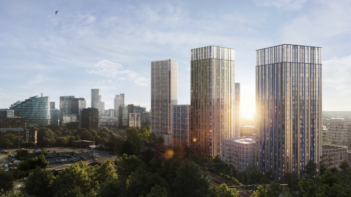Far East Consortium, the developer working in a joint venture-partnership with Manchester City Council on the £4 billion Victoria North regeneration project, said it has appointed CR Construction to build the next phase of 895 homes there.
FEC got planning permission in August 2023 for 1,551 new homes, across plots known as NT02, NT03 and NT04, along Dantzic Street, together with a separate outline planning permission for a further 3,250 new homes, all within a neighborhood to be called Red Bank.
The homes will follow the developer’s ‘Wild Urbanism’ concept, which it says seeks to prioritise green space, biodiversity and active travel.
CR Construction is currently working on FEC’s neighbouring 634-home Victoria Riverside development which is due to complete in early 2025. CR will now build the next phase of Red Bank Riverside on plots NT02 and NT03 on Dantzic Street, which will include a collection of three towers reaching 20, 31 and 34 storeys, and another mid-rise, nine-storey block set within extensive public realm.
The scheme was designed by Hawkins\Brown Architects and Schulze+Grassov in collaboration with Optimised Environments landscape architects.
Work is due to start on site early next year, following the completion of the enabling works by Manchester City Council and its appointed contractor BAM, which is funded under the Housing Infrastructure Funding secured by the joint venture in 2019.
Nick Whitehouse, Delivery Director at FEC, said: “The execution of this contract to deliver the next phase of Red Bank Riverside is another significant milestone for one of the country’s largest regeneration projects. We’re pleased to engage the market leading skills of CR Construction on this exciting project.”
Victoria North is one of the UK’s largest and most ambitious regeneration projects and the biggest in Manchester’s history. Over the next two decades, it will create 15,000 homes northeast of Manchester city centre, and is expected to increase the population by 40,000, creating seven new and distinct neighbourhoods, making use of largely under-utilised and brownfield land.
